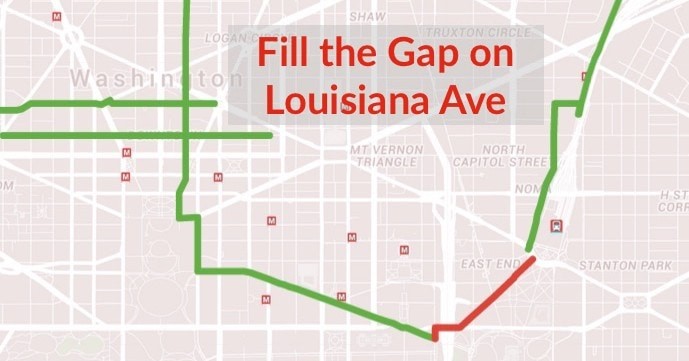The Senate Sergeant-at-Arms and 37 parking spots stand in the way of a Louisiana Avenue bike lane

Rendering of the Louisiana Avenue protected bikeway with a concrete barrier. Image by DDOT.
The four-year-old plan to add a protected bikeway to Louisiana Avenue is at a standstill while the District Department of Transportation (DDOT) continues to negotiate the street design with Congress. The primary sticking point for the 0.6-mile-long lane? The Senate Sergeant-at-Arms (SAA) doesn’t want to give up 37 parking spaces.
Until the parking problem and seven other issues identified by the Architect of the Capitol (AOC) are addresssed, DDOT’s design contract process is in a holding pattern. DDOT has created conceptual plans and conducted traffic analysis for a median-running two-way bikeway that would connect Pennsylvania Avenue to First Street NE and the Metropolitan Branch Trail. However, it won’t create a formal design until it has some agreement from the federal government.
Red segment shows the current existing gap between Union Station and Pennsylvania Ave. Image by WABA used with permission.
Louisiana Avenue, like many roads near the Capitol, is owned by the Architect of the Capitol. While AOC is supportive of the protected bike lanes, the parking located betwen North Capitol and Columbus Circle is managed by the Senate SAA. It’s unwilling to lose any parking, even though there are currently as many as 5,800 parking spaces on the House side, and likely as many on the Senate side.
When DDOT started looking at adding a protected bike lanes to Louisiana Avenue, it met with the AOC about transfering the road back to DC, but found it unreceptive. DC did, however, receive tentative support for pursuing a two-phase option in which phase I retains the parking in the short term and adds sharrows until a better bike facility can be added to that block later.
Alas, DDOT can’t get an agreement, even for the phasing proposal that wouldn’t remove parking. The agency also offered to add more parking elsewhere by replacing curbside spaces on First Street NE south of Columbus Circle with angled spots, to no avail. First street used to go through but now it’s barricaded south of C Street and gets less traffic, so it would have been an ideal spot.
DDOT would like to do the road work in coordination with PEPCO’s Capital Grid project, which will be installing 10 miles of new transmission lines, some of it along Louisiana and Constitution avenues. That project is meant to take place from 2019 to 2026, but it has not been determined when in that window the section relevant to this project would be done. It would be a shame if a delay over parking causes the agency to miss this opportunity.
Last October, DDOT presented its conceptual plans at a panel convened by Delegate Eleanore Holmes Norton at the Capitol. Both the SAA and the AOC declined to attend at the last minute, leaving only those who supported the project to discuss it among themselves.
DDOT offered several options, but its preferred one is a bi-directional center-running protected bikeway that would remove the left turn lane. Placing the bikeway in the middle of the road means it would not interfere with bus operations or parking, and would better connect to a similar lane on Pennsylvania Avenue. Between Pennsylvania and Louisiana, the bikeway would continue in the middle of the road on Constitution. At Columbus Circle, people bicycling would use the existing bike lanes or the sidewalk to connect to the Met Branch Trail.
Median bikeway on Constitution Avenue. Image by DDOT.
Louisiana Avenue is included in WABA’s 20-by-20 plan to build 20 miles of bike lane by 2020. However, it remains captive to the same parking preservation concerns that hold up other projects. There was some hope that the SAA’s opposition would disappear when a new SAA was chosen in 2018, but it appears that has made little difference.
If the AOC approves the project, it will still need to be approved by the Senate Rules Committee and the House Office Building Commission, get cleared for environmental concerns, define the easement, and complete a final design before it can start construction. Finishing all of that by the end of 2020 isn’t going to be easy.
